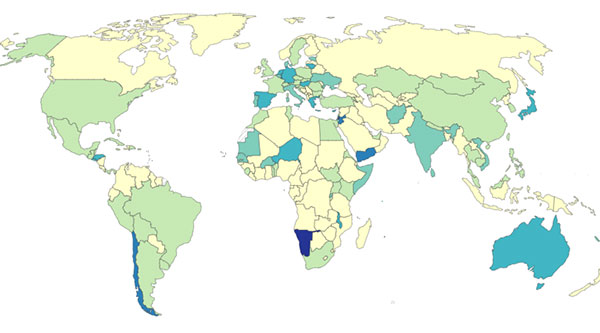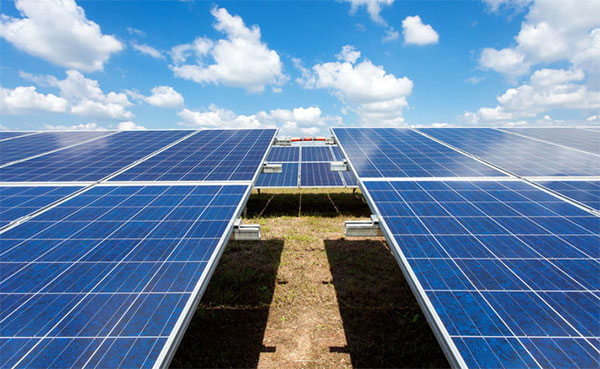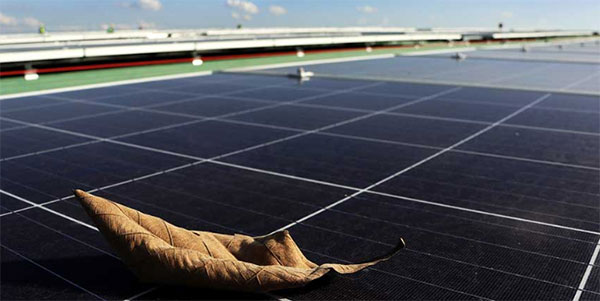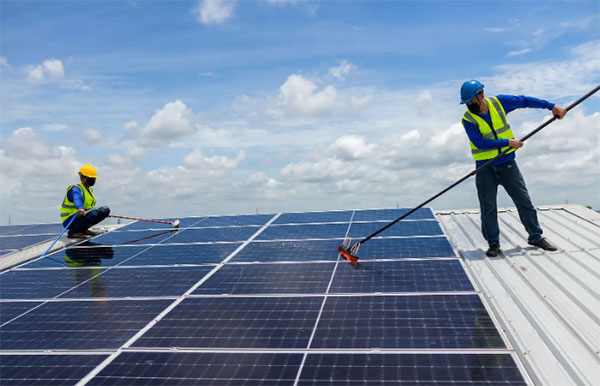
Technological Advances in Solar Energy
The field of solar energy has seen remarkable advancements, reshaping its role in the global energy landscape. These advancements encompass not only the efficiency of solar panels but also innovations in energy storage, making solar a more viable and reliable energy source.
Evolution of Solar Panel Efficiency
Solar panel efficiency has experienced significant improvements over the past decade. Modern solar panels commonly achieve efficiencies of around 15-20%, a substantial increase from earlier models. High-efficiency panels, like those used in space applications or in premium residential installations, can reach efficiencies above 22%. This leap in efficiency owes much to the development of new materials like perovskite and advancements in silicon cell technology.
Key milestones in this evolution include:
- Introduction of monocrystalline and polycrystalline silicon cells, offering better light absorption and durability.
- Development of PERC (Passivated Emitter and Rear Cell) technology, enhancing light capture and electron retention.
- Use of bifacial solar panels, which capture sunlight from both sides, potentially increasing energy yield by up to 27%.
Innovations in Solar Energy Storage
As solar energy is intermittent, storage solutions are vital for ensuring a steady energy supply. Innovations in solar energy storage have largely focused on battery technology and grid integration.
Key developments include:
- Lithium-ion batteries, known for their high energy density and long lifespans, have become the standard in solar energy storage. The cost of lithium-ion batteries has plummeted, dropping by almost 90% over the past decade.
- Flow batteries, offering scalability and longer discharge times, are emerging as a promising solution for large-scale solar installations.
- Integration with smart grid technology, allowing for more efficient energy distribution and management, adapting to varying energy demands in real-time.
These technological advances, along with the falling costs of solar panels and batteries, have made solar energy more accessible and affordable, propelling its growth as a key player in the renewable energy sector. The ongoing research and development in this field suggest that the efficiency and storage capabilities of solar energy systems will continue to improve, further enhancing their cost-effectiveness and reliability.

Economic Analysis of Solar Energy
The economic landscape of solar energy has undergone a significant transformation, making it one of the most cost-effective sources of renewable energy. This analysis delves into the cost trends in solar panel production and compares solar energy with traditional energy sources in terms of financial viability.
Cost Trends in Solar Panel Production
The cost of producing solar panels has been on a steep decline, largely driven by technological advancements and economies of scale. The average cost of a solar panel has decreased by more than 70% in the last decade. In 2010, the cost per watt was around $2, but as of 2023, it has plummeted to below $0.20 in some cases. This drastic reduction stems from:
- Improvements in manufacturing efficiency: Automated production lines and advanced manufacturing technologies have reduced labor costs and material wastage.
- Advancements in material science: The use of thinner silicon wafers and alternative materials like cadmium telluride has reduced the amount of expensive raw materials required.
- Increased market competition: The entry of new manufacturers, especially from China, has created a competitive market environment, driving down prices.
Comparison with Traditional Energy Sources
When comparing solar energy with traditional energy sources like coal, natural gas, and nuclear power, several economic factors stand out:
- Lower operational costs: Solar energy systems have minimal moving parts and require less maintenance, resulting in lower ongoing operational costs compared to traditional power plants.
- Fuel costs: Solar energy, unlike fossil fuels, does not incur fuel costs. The sun provides a free and abundant energy source, making solar power immune to market fluctuations in fuel prices.
- Environmental impact: While not directly a cost factor, the environmental advantages of solar energy, such as reduced greenhouse gas emissions and air pollution, translate into economic benefits in terms of public health and climate change mitigation.
The levelized cost of energy (LCOE) is a useful metric for comparing the cost-effectiveness of different energy sources. Recent studies have shown that the LCOE of solar energy is now competitive with or even lower than that of fossil fuels in many regions. This competitiveness is expected to increase as solar technology continues to advance and as the world transitions towards more sustainable energy sources.
The economic analysis highlights solar energy not only as a sustainable choice but also as an increasingly economically viable alternative to traditional energy sources. This shift is expected to accelerate the adoption of solar energy globally, further driving down costs through increased scale and technological innovation.

Global Solar Energy Adoption
The adoption of solar energy has seen an unprecedented surge globally, with countries across different continents embracing this renewable energy source. This surge attributes to solar energy's declining costs, technological advancements, and increasing environmental awareness.
Case Studies: Success Stories Around the World
Several countries stand out as leaders in solar energy adoption:
- Germany: Known for its 'Energiewende' policy, Germany has been a pioneer in solar power. Despite its less-than-ideal climate, Germany had installed over 40 gigawatts (GW) of solar PV capacity by the end of 2020.
- China: As the world's largest producer of solar panels, China leads in solar energy capacity, boasting over 200 GW by 2020. This remarkable expansion is a result of the government's aggressive policies to reduce carbon emissions.
- United States: The U.S. solar market has grown rapidly, with California leading the way. The U.S. had over 60 GW of solar PV installed by 2020, largely driven by federal tax credits and state-level policies.
- India: India has made significant strides in solar energy, aiming to reach 100 GW of solar capacity by 2022. The country's National Solar Mission has been a critical driver in its solar adoption.
Geographic Variations in Solar Energy Costs
Solar energy costs can vary significantly across different regions due to factors like:
- Solar irradiance: Regions closer to the equator, like parts of Africa and the Middle East, receive more sunlight, making solar energy more efficient and cost-effective.
- Government policies: Subsidies, incentives, and tariffs play a crucial role in the economics of solar energy. Countries like Germany and China have effectively used policies to lower the costs of solar energy.
- Local labor and installation costs: The cost of labor and installation varies by region, affecting the overall cost of solar systems. Developing countries often have lower labor costs, which can make solar installations more affordable.
- Market maturity and competition: In regions with a well-established solar market, like Europe and North America, increased competition among suppliers and installers drives down prices.
These variations highlight the importance of considering local factors when analyzing the economic feasibility of solar energy. Despite these differences, the global trend shows a steady decline in solar energy costs, making it an increasingly attractive option for countries around the world. The continued growth in global solar adoption is a testament to its viability as a key component of the world's energy mix.
Government Policies and Incentives
Government policies and incentives play a pivotal role in shaping the solar energy landscape. These measures not only promote the adoption of solar energy but also accelerate the development of the solar industry.
Impact of Subsidies and Tax Breaks
Subsidies and tax breaks significantly reduce the cost of solar energy systems, making them more accessible to a wider range of consumers and businesses. Key aspects include:
- Feed-in Tariffs (FiTs): Governments, like those in Germany and Japan, have implemented FiTs, allowing solar energy producers to sell surplus electricity back to the grid at a guaranteed price, thus ensuring a return on investment.
- Investment Tax Credits (ITC): In the United States, the ITC has been a major driver for solar investment, offering a 26% tax credit for solar PV systems on residential and commercial properties.
- Reduction in VAT and Import Duties: Several countries have reduced VAT or import duties on solar components, significantly lowering the overall cost of solar installations.
These incentives have not only spurred growth in solar energy adoption but also attracted investments in solar technology, leading to increased efficiency and lower production costs.
International Agreements and Solar Energy
International agreements play a crucial role in shaping global solar energy policies. These agreements often set targets and frameworks for renewable energy adoption:
- Paris Agreement: Under this landmark international treaty, many countries have committed to reducing greenhouse gas emissions. Solar energy, as a clean and renewable source, is crucial in achieving these targets.
- International Solar Alliance (ISA): Founded by India and France, the ISA aims to promote solar energy in countries rich in sunlight. It facilitates cooperation on technology, finance, and capacity building.
The synergy between national policies and international agreements creates a conducive environment for the growth of solar energy, helping to combat climate change and drive economic growth in a sustainable manner. The continued support from governments and international bodies is vital for the ongoing expansion of solar energy globally.

Challenges and Limitations of Solar Energy
While solar energy presents many benefits, it also faces certain challenges and limitations that affect its adoption and effectiveness.
Intermittency and Storage Issues
One of the primary challenges of solar energy is its intermittency – solar panels only generate electricity when the sun is shining. This limitation necessitates the development of efficient storage solutions to ensure a consistent energy supply.
- Battery Storage: The most common solution is battery storage, typically using lithium-ion batteries. These batteries store excess energy generated during sunny periods for use at night or during cloudy weather. However, the high cost and limited lifespan of batteries can be a barrier.
- Grid Integration: Integrating solar power into the existing power grid poses challenges due to its variable nature. Grids must be able to adjust to the fluctuating power supply from solar sources, requiring advanced grid management and energy storage systems.
Environmental and Land Use Considerations
Solar energy, although environmentally friendly, has its own set of environmental and land use considerations:
- Land Footprint: Large-scale solar farms require significant land, which can lead to habitat disruption and land use conflicts, particularly in densely populated or ecologically sensitive areas.
- Resource Use and Waste: The production of solar panels involves the use of hazardous materials and generates waste. Responsible sourcing of materials and recycling of solar panel components is crucial to minimize environmental impact.
- Water Use: Some solar thermal power plants require water for cooling, which can be a concern in arid regions.
While these challenges are significant, ongoing research and technological developments continue to address them, enhancing the efficiency and environmental sustainability of solar energy. As the technology matures, these limitations are likely to diminish, making solar energy an even more attractive option in the global energy mix.

The Future of Solar Energy
The future of solar energy looks bright, with projections indicating continued growth and technological advancements. This energy source is set to play a pivotal role in the global energy transition towards more sustainable practices.
Projections and Emerging Technologies
The future of solar energy is marked by exciting projections and emerging technologies:
- Increased Efficiency: Ongoing research aims to increase the efficiency of solar panels beyond the current average of 15-20%. Emerging technologies like perovskite solar cells offer the potential for higher efficiencies at lower costs.
- Solar Energy Storage: Advancements in energy storage, particularly in battery technology, are crucial. The development of cheaper and more efficient storage solutions, like solid-state batteries, is expected to address the intermittency issue of solar energy.
- Building-Integrated Photovoltaics (BIPV): BIPV technology integrates solar cells directly into building materials, like roof shingles or windows, offering a seamless way to incorporate solar energy into urban environments.
Solar Energy in the Context of Global Energy Transition
Solar energy is a key player in the global shift towards renewable energy:
- Reducing Carbon Emissions: Solar energy's role in reducing carbon emissions is vital in meeting the goals set by international agreements like the Paris Agreement. By replacing fossil fuels, solar energy significantly cuts greenhouse gas emissions.
- Energy Independence: Solar energy reduces reliance on imported fuels, enhancing energy security for many countries.
- Economic Benefits: The solar industry creates numerous jobs, from manufacturing to installation and maintenance, contributing to economic growth.
The ongoing advancements and increasing affordability of solar energy make it a cornerstone of the global transition to sustainable energy. Its role is set to expand further, with solar energy becoming a more prevalent and integral part of the world's energy mix.








